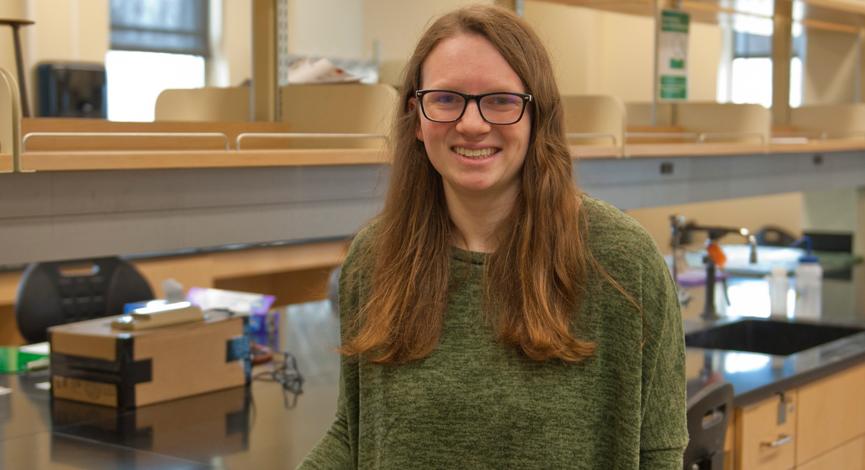
During her on-site interview for a summer internship at the National Institutes of Health (NIH), junior biochemistry major Amanda Sugrue spoke in depth about her current research – a kinetic study that examined an enzyme found in beef heart. In a stroke of luck, the interviewer, Dr. Sameer Isaaq, is studying the same enzyme and the role it plays in kidney cancer.
“I had done a 50-page paper on my research,” says Amanda. Last month, she learned that she will be paired with Dr. Isaaq for a 10-week summer internship, Introduction to Cancer Research, at the NIH’s Urological Cancer Research Branch, where she will be trained in basic cancer research techniques.
“I’ll be doing cell cultures using molecular biology techniques to understand the role of metabolic pathways in kidney cancer,” explains Amanda, who’s been interested in cancer research since high school. She is one of just 14 undergrads nationwide accepted into the prestigious NIH internship program. Additionally, she received the Cancer Research Training Award, which provides a stipend, including housing.
“Since high school biology, I’ve been really interested in the way very small things changing within a cell can have this massive explosion and cause so many problems in the human body,” she says. Heidelberg’s biochemistry program was the ideal landing for her.
Amanda knows the value of internships. She has supplemented her biochemistry coursework with a summer internship at Cincinnati Children’s Hospital, where she studied the effects of pollution on changes in brain tissue. In conjunction with Dr. Kylee Spencer’s cellular biology class, Amanda and several ‘Berg students traveled to St. Jude’s Children’s Research Hospital in Memphis, Tennessee, for a week last spring.
“During our class, we were learning about new cancer therapies called immunotherapies,” Amanda says. While at St. Jude’s, the Heidelberg students got hands-on experience with the young patients and in St. Jude’s labs. That experience really solidified Amanda’s career path.
Amanda’s NIH internship is another feather in the cap for Heidelberg’s four-year-old biochemistry program, which has placed students in a Ph.D. program at Brown University, medical school at the University of Cincinnati and an internship at the U.S. Department of Energy’s Oak Ridge National Laboratory in Memphis, Tennessee.
According to chemistry professor Dr. Nate Beres, Heidelberg’s biochemistry program provides excellent interdisciplinary training for those students interested in medical applications. “It’s the go-to program for anyone interested in medical programs,” he says. “Our program gives them flexibility to choose electives according to their interests.” The biochem major is about exposing students to a wide variety of techniques and helping them explore their passion, Nate says. “It’s a very difficult program, but there are a lot of rewards.”
For Amanda and her interest in cancer research, internships are important because larger labs provide opportunities to learn the basic research techniques students will be expected to practice in grad school.
But before her internship, she has another trip planned. Chemistry and biochemistry students will head to Orlando next month, where Amanda and six of her classmates will be presenting their research at the American Chemical Society national meeting. Her presentation is titled “The Quantification of Nitric Oxide Released from a Wound-Healing Patch.”
Following graduation in 2020, Amanda plans to enter a Ph.D./M.D. graduate program. She has her sights set on a career where she’ll have opportunities to become involved in clinical trials involving drug development related to cancer treatment options.